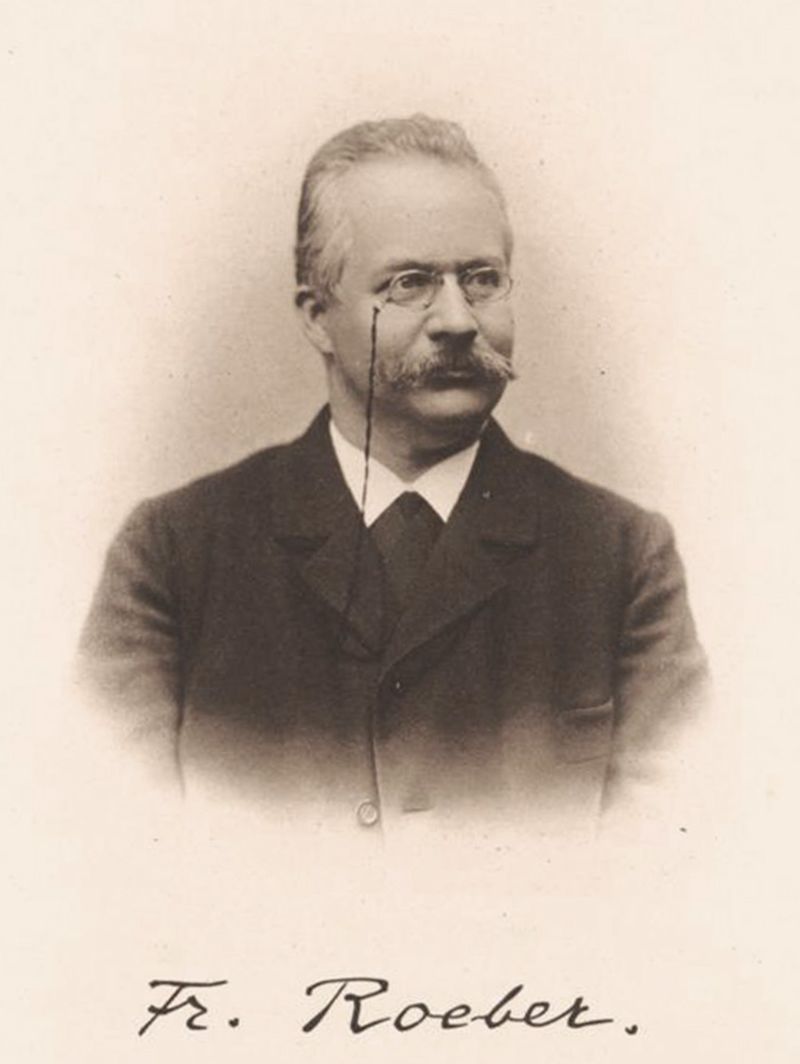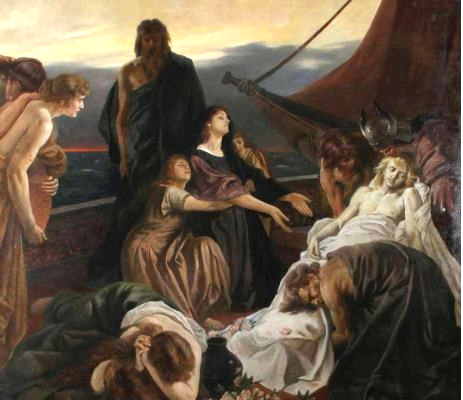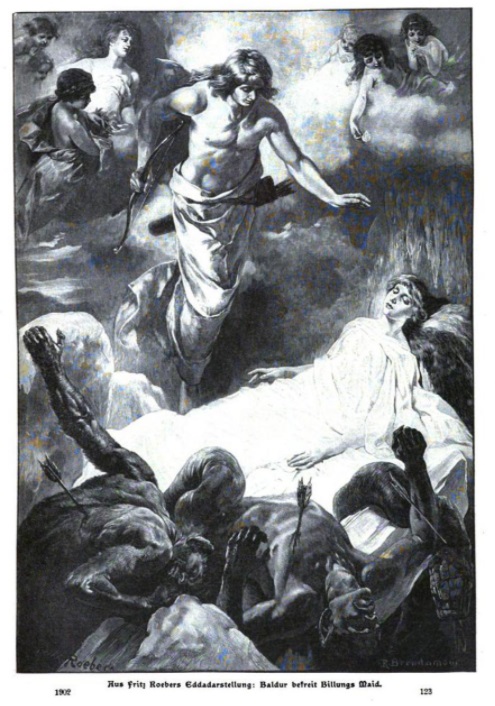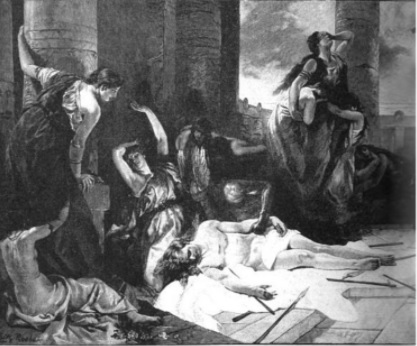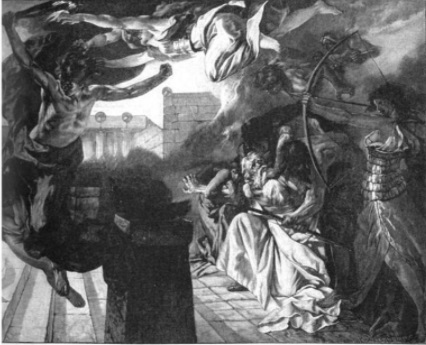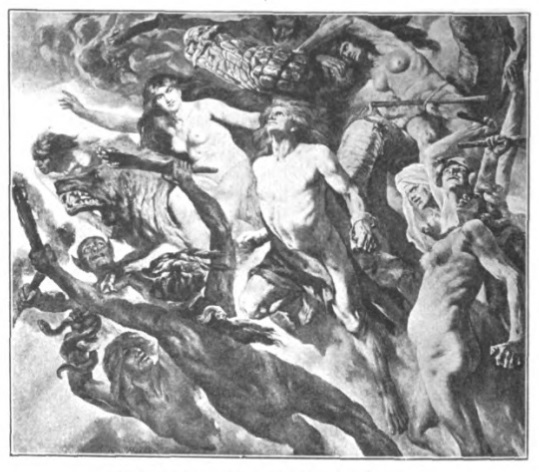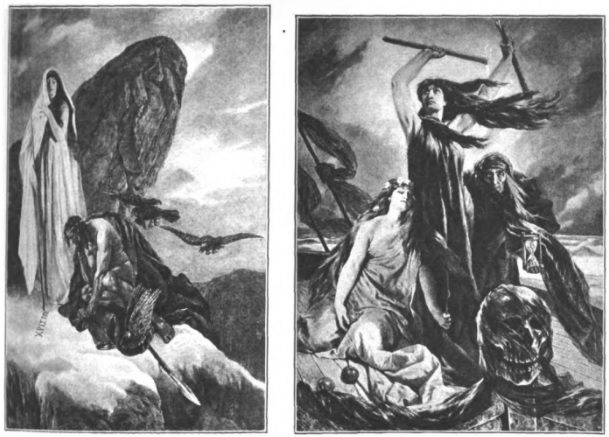Fritz Roeber
Edda Darstellung / The Edda Presentation
[HOME][POPULAR RETELLINGS]
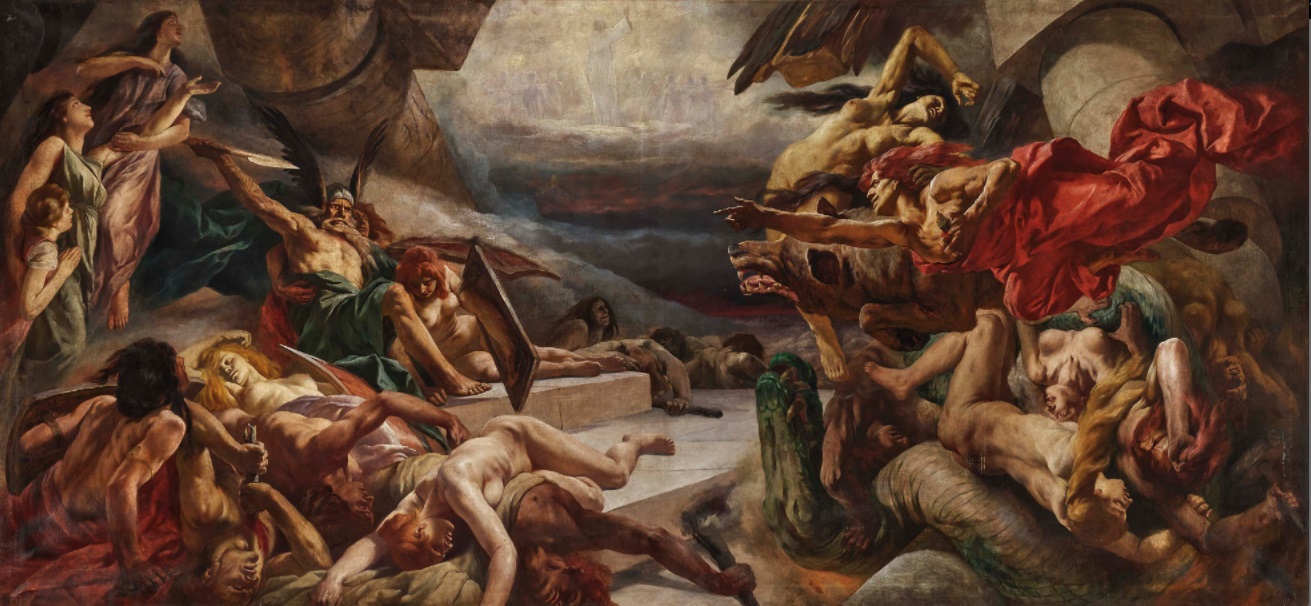 Valhall's Fall |
|
Fritz Roeber [Frederich
Röber], the
celebrated Düsseldorf master,
son of Elberfeld's authorized signatory and writer Friedrich
Roeber, was born in Elberfeld on October 15, 1851.
Roeber attended the Elberfeld high school for nine years.
While still young, he moved to
From 1908 to 1921 he was director of the Düsseldorf Academy which had a conservative reputation, where he advocated groundbreaking structural innovations. In 1909, workshops for church art and glass were established under Roeber's initiative. In 1919 parts of the Düsseldorf School of Applied Arts were incorporated into the Art Academy. In an effort to expand the art academy to include architecture and other branches of the applied arts, seven new teachers were brought to the academy and committed under Roeber's aegis: the painter Ludwig Heupel, the sculptor Hubert Netzer, the graphic artist Ernst Aufseeser, and three architects: Wilhelm Kreis, the previous director of the Kunstgewerbeschule, Emil Fahrenkamp and Fritz Becker. With the construction of new academy and a studio complex called the "New Art Academy" near the banks of the Rhine, he realized the ideal of an "art city based on the English model". In 1921 he was made an honorary citizen of the city of Düsseldorf. Fritz-Roeber-Straße on the north side of the main building of the Düsseldorf Art Academy was named in his honor. His brother Ernst (1849–1915) also taught at the art academy. Roeber died May 15, 1924, in Düsseldorf. His grave is in the Düsseldorf North Cemetery.
Roeber's figures breathe the spirit of Romanticism most purely, representing the view of the Düsseldorf School that decorative monumental painting is the artist's most creative endeavor. In 1900, Roeber executed an Edda sequence in individual frames, forming the frieze of a room in the house that the well-known collector and art lover Karl von der Heydt had built near Godesberg. Each individual picture is self-contained and represents an episode from the life of the native Nordic gods. The entire sequence of pictures is a treatment of the Edda, depicting the work of the gods of nature, all grouped around its favorite, Baldur, the god of sunlight. The annual myth is now deepened. The triumph of the bright sun, the giver of life, over winter symbolizes the collapse of the whole world of gods to the artist. But, at the same time, requires the coming of a new light, a new religion, Christianity. Source: Die Gartenlaube, 1902 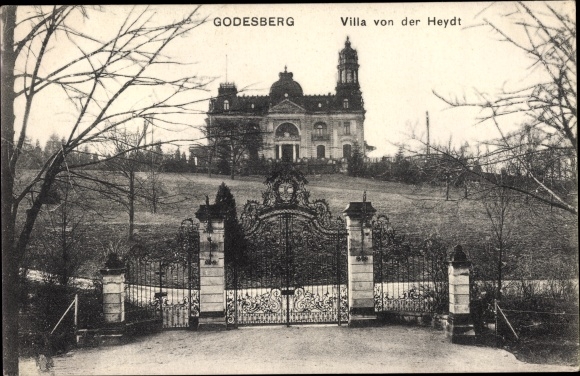 
Fritz Roeber created a large mural in the form of a panorama picture in the billiard room of the Villa von der Heydt in Bad Godesberg. The present painting was part of an eleven-part cycle with the theme "Untergang der nordischen Götterwelt und Erscheinen des Christentums auf der neuen Erde", ["Fall of the Nordic Gods and Appearance of Christianity on the New Earth"]. The first picture shows us the father of gods and light, Wodan. Frightening signs of the end of his rule have appeared to him, and in order to interpret them he has ridden into the realm of winter and death that preserves the germs of the future. Volva or Wala, the knowing prophetess in this kingdom of Hel, has confirmed every fearful ancestor: Baldur, the god of light, will die, the sun will set. She also tells him that the hand of the blind Hödur, the mighty winter, will kill him. In vain, the old god, the primordial power of life, seeks to find out from Wala who will one day avenge Baldur, who will triumph over darkness as the new light. In maternal concern, however, Freya, Baldur's mother, tries to prevent the story. She hurries through fields and meadows to take under oath everything that is there— stones and rocks, trees, all animals and plants— that they will honor Baldur. When she had taken all the vows, she returned to Valhalla calmly. But in the winter kingdom she had forgotten to consult one thing, the inconspicuous mistletoe. While this first picture is to be accepted as a kind of ominous prologue, the actual annual myth now begins with the following pictures. The second painting glorifies the victorious outdoors of the young spring sun around the wintry earth in her snowy bed. One picture illustrates this. After a long and unsuccessful recruiting, Baldur descended to Billung's maiden, the “sun-white” still sleeping earth. The ice crust of the earth loosens, the brooks flow, and the earth gives the sun the minne-potion.
The gold-rich woman, the dweller in the wintry hall, has married the sun god. So they walk together in the third picture. Gold-joy, the blessed earth, produces its seed-rich plots. The most beautiful season of the year, the blooming earth, is depicted in this graceful picture. But suddenly the end of happiness breaks in. Iduna, a scion of the earth, has sunk down from the green branches of the world tree Yggdrasil. The leaves on the trees have fallen and turned brown. At Aegir's drinking-feast at harvest time, Loge, the embodiment of the devastating autumn glow, the cause of the earthquake, had blasphemed the gods. Only before the thunder, the dampener of sultriness, had he withdrawn once more. So one sign after another comes and indicates the upcoming winter season. And soon Loge is given the opportunity to carry out his intention to overthrow the sun. When the gods played with Baldur, the sunlight, their eternal love, and threw spears at him, while he stood in the middle of the room, protected from all harm by the oaths his mother had taken from all beings, this was when the envious Loge carried out his evil deed. He knew that the mistletoe, which grows in winter, was not responsible for the summer light, Baldur. From this bush he cut an arrow, put it on blind Hödur's bow with cunning persuasion, and directed the projectile at Baldur who was mortally wounded by it.
Then the Aesir took hold of Loki and tied him with the bowels of his son Narvi. But his son Narvi became a wolf, the father of the night. And they took a poisonous snake and fastened it over Loge's face, so that it was hit by the poison that dripped down. Sigyne, Loge's wife, took it and held a bowl under the poison. That is the scene that Roeber captured in the fifth picture. But when the bowl was full, she carried away the poison, and meanwhile it dripped onto Loge. Then he shook himself so badly that the whole earth shook with it. That was now called an earthquake.
In the seventh picture, Roeber shows us the degenerate state of deity after Baldur's death. The gods immerse themselves in the pleasures of gold and wealth that the earth mother Frigg brought them and the Wanes, the wards of the elements, to which Loge also belongs.
Wodan calls his followers to fight, among the first is, Donner, hammer in fist, "with threatening zeal." Against them and against the castle of the gods, in the eighth picture the spirit of annihilation, Loge, comes up in torn fetters. And around him are the forces of darkness, the armies from the Land of Flames, and the Mitgard-snake, the fog-producing, earth-encircling sea. "From the south the Black one comes with that sword" and the Fenriswolf, the father of the night.
The meaning of the ninth picture is also gloomy and ominous. “Naglfor”, a ship of the giants, of the elementary forces of nature, of Loge's allies, has broken free, and thus the end of the world is sealed according to the Norns' prophecy. The three Norns, dying, proclaim ruin.
The Aesir have fallen, Loge's entourage is also dead. The sea-snake, the Mitgard serpent, has killed Donnar with its venom. But it too has fallen, and dying Loge calls the Fenriswolf from Hell's Gate to the remaining Odin. It is the moment that the tenth picture represents. Newly rejuvenated, the world rises again. For the artist, it is the world of the new faith that follows the collapse. Faith, love, hope, the three Christian virtues shown in the final picture, take the place of anxious doubts about the eternity of natural forces.
|
|||||||||
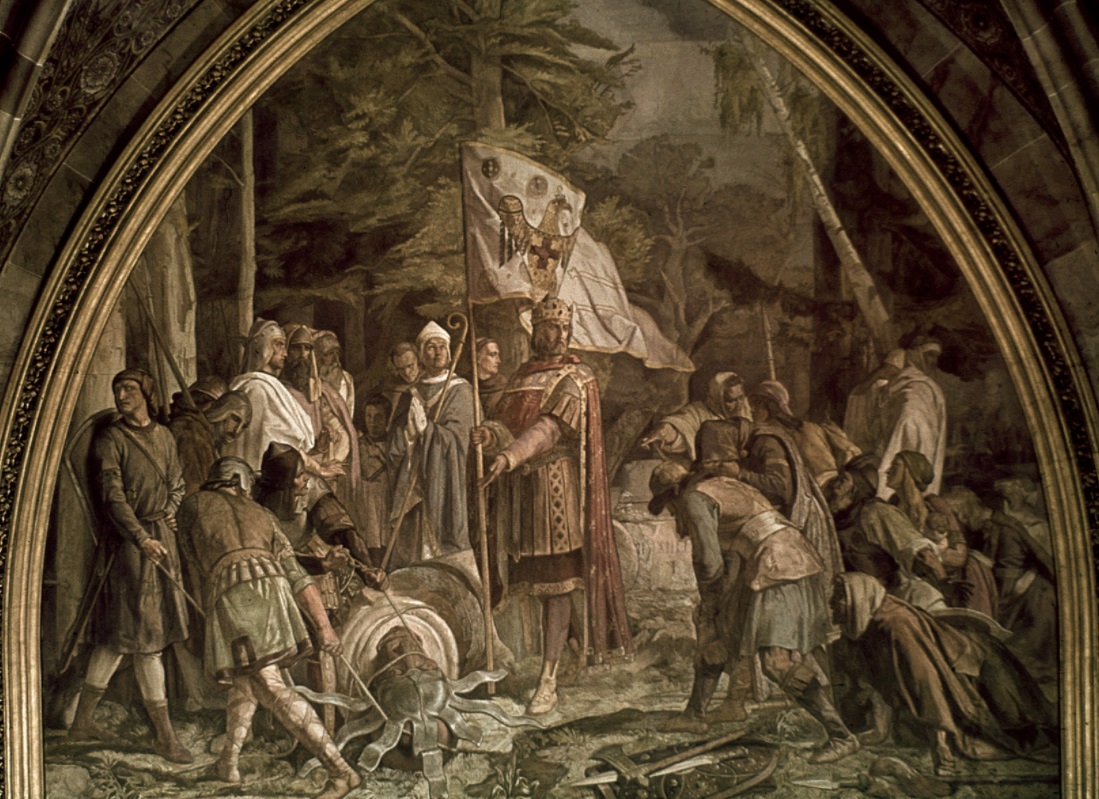 The Destruction of the Irmunsul Aachen Rathus |
|||||||||
|
Other works by Roeber, a watercolor cycle based on the legend of the Rosenburg near Bonn; a cycle of wall paintings in the house of a member of the state parliament, Emil Weyerbusch; wall paintings in the auditorium of the Academy in Münster in Westphalia; and the mosaics at the Düsseldorf art gallery. He remained connected to the Düsseldorf Academy of Art throughout his life, from 1893 as a teacher, from 1908-24 as director. Fritz Roeber and his brother Ernst are a representative of Düsseldorf monumental painting, for which they carried out numerous public and private commissions, amongst others in the Gürzenich, Cologne, or in the domed hall of the Düsseldorf Kunstpalast. Many of these murals are no longer preserved today. |
|||||||||
 Der Venusberg from the Cycle "The Legend of Rosenburg" 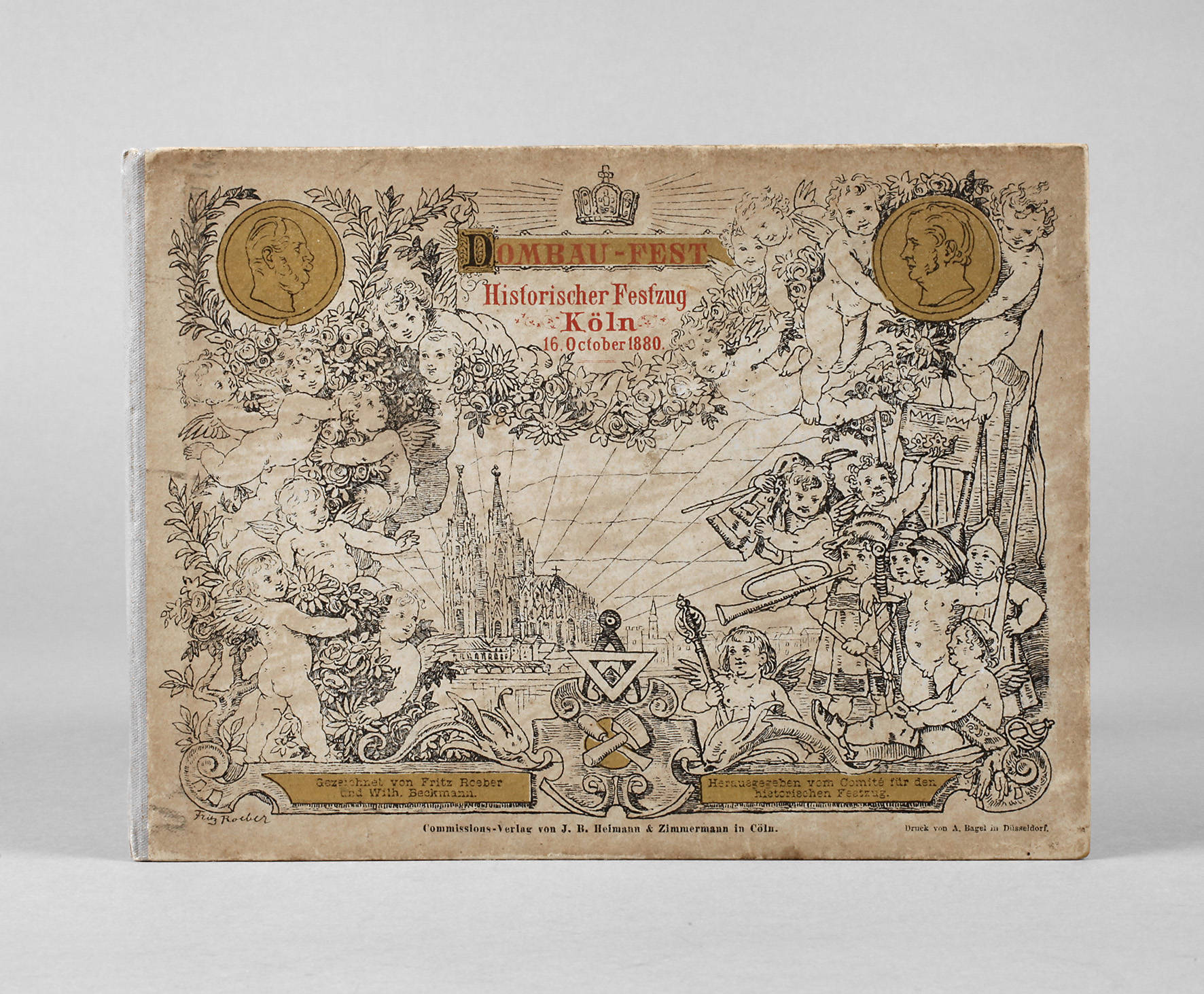 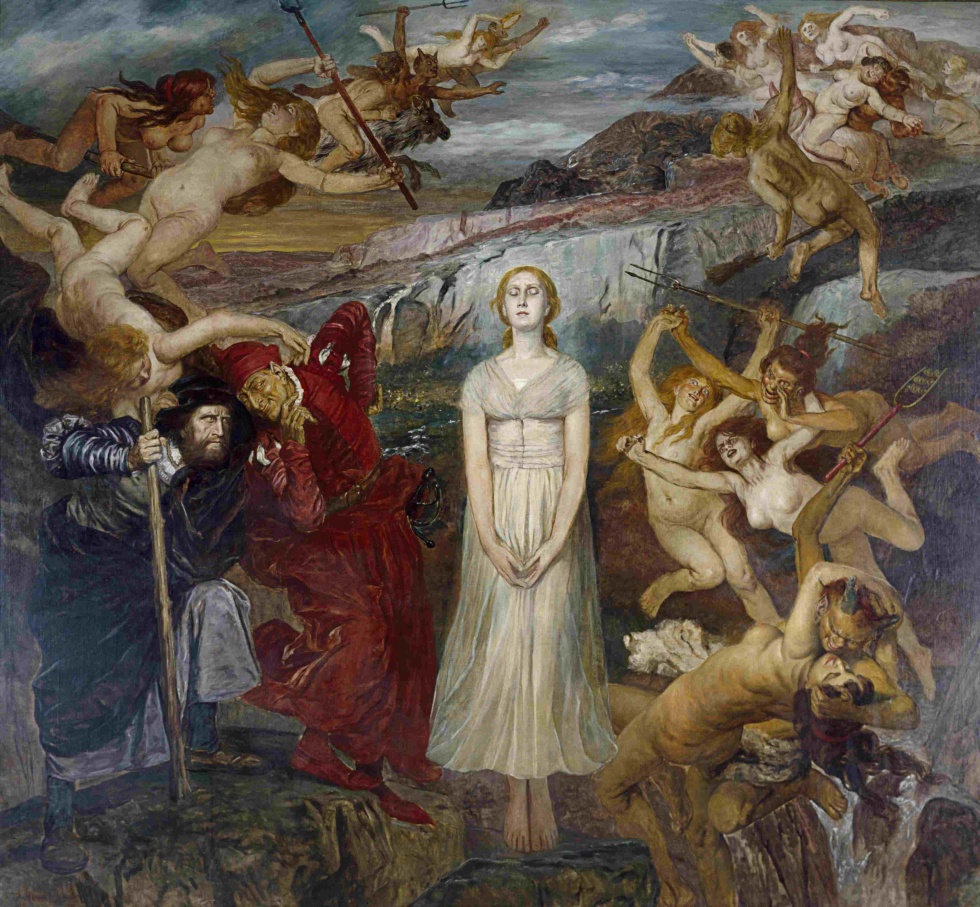 Walpurgisnacht, 1910 |
